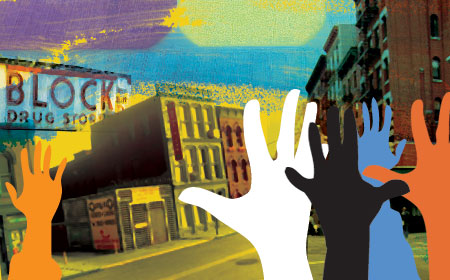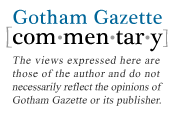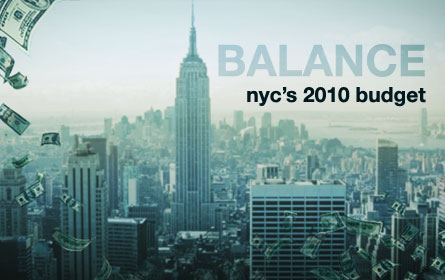Moving Around Downtown

The Lower Manhattan Development Corporation's blueprint for rebuilding lower Manhattan strongly emphasizes transportation. In fact, the corporation says that construction on much of the World Trade Center site cannot begin until transportation improvements are in place.
While I applaud this emphasis, I am not surprised by it. The September 11th tragedy struck a massive blow to the transportation and utility infrastructure of Lower Manhattan. The subway lines, the PATH, major roads and critical utility lines were all knocked out of service -- some for a few days or weeks, others for months and for years to come.
In light of this, one of the keys to the redevelopment of Lower Manhattan is not only what the site is ultimately going to look like, but how we get people in and out of the area. In addition, tragedy has left us with a tremendous opportunity -- a clean slate to work with. So another key issue is how we can use the rebuilding process to rectify a number of the planning mistakes that were in place before September 11.
For people who worked downtown, lived downtown, or even tried to go downtown before September 11, lower Manhattan was a hodgepodge of subway and commuter lines. Often you could not connect from one line to another line. There was no one link bringing everything together. Instead, you had to go through caverns of underground walkways and at times probably thought you would never reach the subway line you needed. Although a fairly active ferry service came into the Battery Park City north cove, there was no connection to bring the people to the buildings where they worked or to the subway lines. And the major commuter transportation line coming into lower Manhattan, the PATH, also did not connect to all the subway lines.
To correct this, the Lower Manhattan Development Corporation has called for a new hub connecting subway, commuter rail and ferry lines. This would probably mean the creation of an actual terminal in lower Manhattan.
In Europe, there are many grand terminals that are really testimonials and memorials to great times in European history and to great battles. Maybe the new downtown transportation terminal could be another memorial to the people who lost their lives on September 11.
The hub could be a beacon for lower Manhattan. It would serve as a station for the PATH train and for all the subway lines. At 42nd Street on the West Side, one subway station pretty much links you up with all the train lines. This downtown terminal would do the same thing. It would also connect to the ferry terminal and to various sites downtown. It could include an underground bus terminal for commuter buses and the tour buses that will come downtown to bring visitors to the proposed memorial and museum and other sites. My sense is that the proposed terminal will probably be somewhere along Church Street, but no exact location has been determined yet.
After September 11, we analyzed how people come into lower Manhattan, where are they come from and where they want to go. We found that more than 40 percent of the people who took the PATH train went east to the Wall Street area after they came in, some to buildings, some to subway lines. But there was no way of getting them east below ground. They walked above ground.
This suggests the need to create a link to get people farther east and into our subway system quickly and safely. This could involve an underground pedestrian tunnel and people movers.
Extension of the commuter rail lines into this downtown hub is also being discussed. We now have an ideal opportunity to do this and ease the commute downtown for thousands of Westchester and Long Island residents, but it would be quite costly. Whether or not this should be pursued as opposed to other initiatives remains to be seen.
Many of the other links are already in place. Clearly the Metropolitan Transportation Authority and the Port Authority were stretched to the limit before September 11. Now, though, President Bush's recovery bill of $21 billion includes nearly $2 billion for this initiative, as well as funding for road and infrastructure repair. However, meeting the transportation needs of lower Manhattan has been estimated to cost at least $7 billion.
Some aspects of the plan will eventually save money. Before September 11, the bus routes downtown, as well as truck deliveries, were very cumbersome because of the streetscape. If you remember, Dey Street and Fulton Street did not go through to the river because of the World Trade Center site. Restoring the street grid will make it easier and more economical for trucks and buses to move downtown.
Restoring the street grid will also make the streets more accessible and safer for pedestrians, which is one of my big goals. It will connect lower Manhattan in a more rational way to Battery Park City. As we restore the grid, we can create a number of access points to the street to help passengers safely go to and from the various subway stations, tunnels and people movers.
Burying West Street for all or part of the way between Chambers Street and the Battery Park Underpass, as the development corporation's plan suggests, would make it easier for pedestrians to go from the World Trade Center site to Battery Park City, the World Financial Center and the waterfront. In addition, it would create a swath of land above the new tunnel that could be used as a greenspace or for other purposes.
After September 11, although the PATH was out of service, New York City was able to get back in operation very quickly because of our waterways and our ability to offer ferry service to people coming to Lower Manhattan from New Jersey and Brooklyn. Ferry ridership in New York has nearly doubled since September 11.
Ferry service is an incredibly dynamic and adaptable mass transit option and, perhaps, an underutilized one. Now that we have an abundance of ferry terminals, we should figure out ways to make ferry service competitive even after the PATH comes back. If you price ferry service sensibly, I think you will get a lot of converts to commuting by water
In the months since September 11, we have taken steps to help the area rebuild. Now I am hopeful that six years after the tragedy, we will have created an accessible, revitalized and vibrant Lower Manhattan.
Iris Weinshall is New York City commissioner of transportation.
Posted April 29, 2002
Cutting Back on Democracy

We New Yorkers have dueling psyches. We're worried about the state of the economy, but we are also hopeful about the future and excited about the role of government and citizens in making things better. We know that we are in for lean times. But we also believe that some things are too precious to lose.
Among them are New York City's 59 community boards. In his 2010 budget, unveiled last month, Mayor Michael Bloomberg proposed slashing the community boards' budget by 17 percent.

Clearly the mayor has to cut the budget somewhere. But there are three reasons why, despite the fiscal constraints, we need to maintain community board funding at its current level.
First, the 59 community boards are the people's most direct line to city government, the most effective way to participate in discussions about public policy and quality of life issues -- the closest thing to direct democracy that we have in the city. The public's participation in government is becoming increasingly circumscribed, as important decisions on questions like extending term limits for city officials and appointing replacements for U.S. senators are made essentially behind closed doors, by small groups of officials. This makes it all the more essential to preserve New Yorkers' ability to have their say.
Second, the community boards deal with grassroots issues that directly affect the city's disparate neighborhoods. These include questions as varied as affordable housing, school overcrowding, real estate development, noise, sidewalk cafes and liquor licenses. Often, citizens themselves raise these matters and are intimately involved in shaping the recommendations the boards eventually make. In the recent discussions between Fordham University and the city over Fordham's proposed expansion near Lincoln Center, for example, my community board -- Community Board 7 in Manhattan -- was instrumental in addressing citizens' very real concerns about density, parking garages, open space, design approval and the like. We served as a link between the residents and the city.
And last, while New York City's budget is stretched thinner than ever, community boards provide a significant "bang for their buck." Using the mayor's "business" model, the 50- member volunteer boards, each served by just a few city-paid staffers, are pretty lean structures. The average New York community board receives$220,000 a year -- less than the cost of a subway ride for every person it represents. Together spending on the boards accounts for a total of $15 million in a $60 billion budget. The mayor's proposed cuts -- which would be distributed evenly among the boards -- to an already efficient budget would cripple the boards, all but eliminating their ability to function effectively.
Where the Money Goes
Roughly 70 percent of community board spending is on staff and the remainder goes to "other than personnel services" such as rent, office supplies, postage, equipment and repairs. While the community boards would try to take the cuts as carefully as possible, there is little room to maneuver.
More than likely, the cuts will have a significant impact in two areas: They would diminish the boards' ability to develop zoning and infrastructure plans, and to analyze and conduct public review of development proposals. They also would reduce the boards' ability to communicate with and involve residents, businesses and institutions.
The impact of the cuts to community board budgets are further compounded by di minimus historical increases compared to citywide spending. On average, the rate of annual growth for all city agencies is over twice that of the increases to community boards. According to the Independent Budget Office, since 1980 city spending on community boards decreased over time from .04 percent to .03 percent of total annual city funds.
When the mayor says that the 2010 budget imposes the same budget decrease on all city agencies, it does not take into account the fact that, unlike the other agencies, community boards have received no meaningful increases in their budgets since 1980 making it impossible for them to build up a cushion or keep up with rising costs. In fact, with the historic rising cost of supplies and rent, the community boards have already had to significantly trim their budgets every year.
We are at a delicate juncture when the urgent need for savings can sometimes result in too-hasty decisions. President Barack Obama has brought with him a renewed interest in participatory democracy and a desire for transparency in government. People are more motivated to make a difference in their communities, and New Yorkers need their community boards more than ever. Bloomberg must maintain the current funding level for community boards. It's economical and it's good government. What more can we ask for?
Helen Rosenthal is serving her second term as chair of Community Board 7 on Manhattan's Upper West Side. She has been a member of the Board for nearly a decade. Previously, she worked as an assistant director in the Office of Management and Budget during the Koch, Dinkins and Giuliani administrations where she oversaw the budgets of the city's health care agencies. Until the city passed the term limit extension bill, she was a candidate for New York City Council.
Fix the Budget
No one ever said you needed to start a multi-billion dollar company or get an MBA to set the city's finances straight.
With Gotham Gazette's help, you can increase spending for education or reinstate the commuter tax from the comfort of your own laptop.
Last month, Mayor Michael Bloomberg proposed a $58.8 billion budget that could slash $1 billion from city spending, increase the sales tax by .25 percent (not to mention broaden it to include clothing, hair cuts and more) and seriously lean on Albany and Washington to pitch in billions of additional funding.
So that's his plan. But what would you do?
Bloomberg overturned the city's term limit so he could have a chance to lead the city through this ever-more dreary recession. With our new budget game, BALANCE, you can bypass the City Council entirely and fix our fiscal woes on your own.
Would you increase spending and raise taxes? How about the personal income tax or tolling the East River crossings? Which departmental cuts do you think are the most severe and should be reversed?
Take the reins, but make sure you end balanced or with a surplus. We're not Washington -- we can't run a deficit.
Once you're done, send us the results and we'll report back on how Gotham Gazette readers would balance the fiscal year 2010 budget.
Keep your home page set here, and we'll continue to update you on how the city's real fiscal plan unfolds between now and when our budget must be approved in June.
Play BALANCE now.






